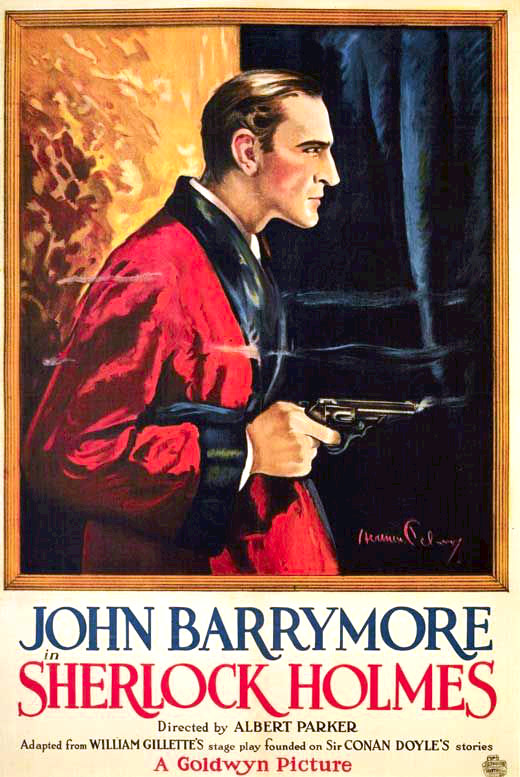Detective and crime-related stories are one of the most popular genres of fiction. In literary form, detective novels are so numerous that publishing companies devote entire labels to the genre and release hundreds of entries per year. Detective/crime-related narratives have become a major part of television programming, with networks basing their entire primetime schedule around crime-related series.

Detective fiction is such an integral part of the current literary landscape that many people have difficulty remembering all its subgenres, popular works, and notable authors. This series explores the history of detective fiction, the authors who were a major influence on its development, and books and films in its major subgenres.
Gothic Genesis
Despite the continuing widespread popularity of Arthur Conan Doyle’s Sherlock Holmes, Doyle did not originate the detective story. This credit must be given to another author of the 19th century, Edgar Allan Poe. In addition to being a major contributor to the literary traditions of Gothic horror and romanticism, Poe also originated the detective story with his character C. Auguste Dupin. When the character first appeared in The Murders in The Rue Morgue (1841), the word detective did not even exist; the character’s name “Dupin” suggests the English word dupe, or deception, which Dupin utilizes in order to obtain the information he requires to solve a case.
Many of Dupin’s characteristics heavily influenced character portrayals of detectives throughout the 19th and early 20th centuries. His cold, logical method or problem solving, upper-class background, and emphasis on intense reading for clues would remain consistent in his portrayals throughout two other Poe stories, “The Mystery of Marie Roget” (1842) and “The Purloined Letter" (1844). Poe only published three Dupin stories over his lifetime before his death in 1849, although other authors have used the character--who is now considered public domain--posthumously, such as Alan Moore's The League of Extraordinary Gentlemen, Vol. 1. Cinematic adaptations of the Dupin stories are rare in comparison to films featuring Sherlock Holmes, although Universal released adaptations of Murders in the Rue Morgue in 1932 and 2004 and The Mystery of Marie Roget in 1942.
“Elementary, my dear Watson”--An Icon Is Born
If Poe was the inventor of the detective novel, it was Arthur Conan Doyle who truly cemented it as a popular literary genre. The first obvious difference between the two authors was in the sheer volume of output. As opposed to Poe, who only created three stories featuring Dupin, Doyle created 56 short stories and four novels featuring Sherlock Holmes. The four Holmes novels Doyle wrote are; A Study in Scarlet (1887), The Sign of the Four (1890), The Hound of the Baskervilles (1901) and The Valley of Fear (1914). The first series of short stories appeared in the Strand Magazine in 1891 and was responsible for the dramatic rise in the character’s popularity. They have also published the collections The Adventures of Sherlock Holmes, The Memoirs of Sherlock Holmes, The Return of Sherlock Holmes, His Last Bow, and The Case-Book of Sherlock Holmes.
One major difference between Doyle’s detective tales and Poe’s is Doyle’s inclusion of a sidekick character to assist Holmes. Dr. Watson, although steadfastly loyal to Holmes, stands in sharp contrast to him. His approaches to problem-solving are populist and simplistic while those of Holmes is complex and sophisticated. He sees the surface of the crime while Holmes tries to plunge into the psychological depths of the criminal. He is emotional while Holmes is scientific. Yet it is overwhelmingly Watson who gives the Holmes stories their point of view, supplying narration for 53 of the short stories and all four of the novels. The interaction between Holmes and Watson and their differing methods of problem-solving is just as enjoyable for the reader as the actual mystery to solve. This relationship is perhaps even more important in the various film adaptations of the Holmes stories.
Holmes in the Age of Cinema
The Holmes stories were one of the earliest mystery series to have film adaptations produced, beginning with the 1914 version of A Study in Scarlet, all prints of which are now completely lost. Although individual adaptations of other Holmes stories starring different actors would continue to be made, the definitive Holmes film series began with 1939’s adaptation of The Hound of the Baskervilles, starring Basil Rathbone as Holmes and Nigel Bruce as Watson. Although 20th Century Fox did not create the film with the intent of starting a series, Rathbone and Bruce proved so popular with audiences as Holmes and Watson that a sequel, The Adventures of Sherlock Holmes, was produced which incorporated elements of several Holmes stories. Following Adventures, Universal obtained the rights to the series from 20th Century Fox and continued making films with Rathbone and Bruce as the lead characters.
Universal’s Holmes films were considerably different from those of 20th Century Fox. The setting was updated from the Victorian era to WWII England and, instead of going against the schemes of Moriarty and other villains from Doyle’s stories, Holmes and Watson were pitted against Nazi spies and other WWII-era dangers. The entries in this series were; Sherlock Holmes and the Voice of Terror, Sherlock Holmes and the Secret Weapon, Sherlock Holmes in Washington, Sherlock Holmes Faces Death, The Spider Woman, The Scarlet Claw, The Pearl of Death, The House of Fear, The Woman in Green, Pursuit to Algiers, Terror by Night, and Dressed to Kill. Four of them, Sherlock Holmes and the Secret Weapon, Woman in Green, Dressed to Kill, and Terror by Night, is public domain, and these are the most frequently shown on television.
“A Case of Identity"
Considered by many to be the most influential Holmes and Watson, the portrayals of Rathbone and Bruce left an indelible mark in the public imagination through their portrayals of the characters. It is Rathbone’s stern, clever, driven Holmes and Bruce’s blundering, comical Watson that most audiences today “see” when they read the original Holmes stories, despite the fact that only one entry in the Rathbone series was actually based on a Doyle story. Rathbone and Bruce were so connected to the characters in public perceptions that they played the roles of Holmes and Watson on the radio series “The New Adventures of Sherlock Holmes” from 1939 to 1947. Audio samples of Rathbone and Bruce from this drama were used for the voices of Holmes and Watson in Disney’s animated film The Great Mouse Detective, a testament to the enduring appeal of Rathbone and Bruce in the roles.
The Sherlock Holmes stories remain popular to this day, and many film and television adaptations have been made after the end of the Rathbone/Bruce series. Among modern actors to play Holmes, Jeremy Brett is perhaps most associated with the role, having played Holmes in several acclaimed television series. Other notable actors to play Holmes include Christopher Lee, Rupert Everett, and, in a Russian-language adaptation popular in the former Soviet Union, Vasili Livanov. A new adaptation of Sherlock Holmes, starring Robert Downey Jr., was released on December 25, 2010, with a follow-up A Game of Shadows, in 2012. Certainly, the enduring popularity of Conan Doyle’s original stories and the many adaptations already produced in the public domain ensure that the character will remain popular for years to come.


